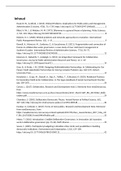Summary
Summary EXAM MATERIAL PAP-30306 (Designing Innovative Governance Arrangements - WUR 2021/2022)
- Course
- Institution
This document contains all the information you need to know for the upcoming exam of Designing Innovative Governance Arrangements (PAP-30306). All articles and the information from the lectures are included. The following articles are covered: - Head, B. W., & Alford, J. (2015). Wicked Problems...
[Show more]



